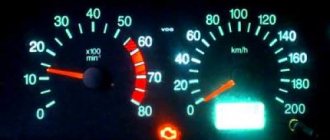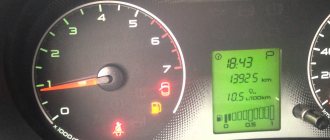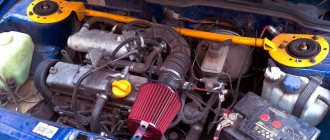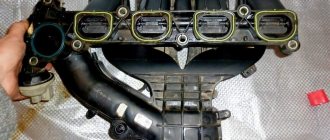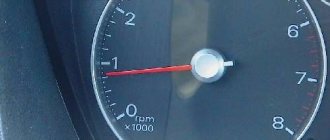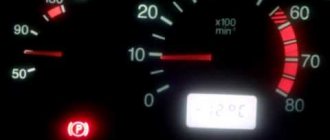Floating speeds should be distinguished from interruptions in operation associated with impaired combustion of the air-fuel mixture in one or more cylinders. In our case, the engine runs smoothly, but the tachometer needle twitches. Let's look at why the idle speed fluctuates and what the driver should do to independently determine the cause of the malfunction.
Suction of unaccounted air
Most often, jumps in engine speed at idle are associated with the suction of unaccounted air into the intake manifold. The engine control unit regulates the opening time of the injectors, relying on the readings of the mass flow sensor (MAF) or absolute pressure sensor (ABP) paired with an air temperature sensor (ATS). The ECU (Engine Control Module) fuel maps contain the desired idle speed, which is maintained using the idle speed controller (IAC) or an electrically driven throttle valve.
In an injection power system with a flow meter, any leakage in the intake tract after the mass air flow sensor will cause unstable engine speed at idle. The actual amount of air entering the cylinders will be greater than the calculated values, which are based on the MAF readings. Also, a lean mixture error often occurs, since the ECU registers unaccounted air only after the fact, based on the readings of the oxygen sensor (lambda probe).
As more air enters the engine, the speed rises, causing a mismatch in the ECU between the desired crankshaft speed and the actual crankshaft speed. Wanting to equalize these values, the controller closes/opens the idle air control or throttle valve, if the IAC is not provided structurally. But due to unaccounted air, it is impossible to set the speed; they begin to rise and fall, which the driver notices by the twitching tachometer needle.
When to set the ignition on a VAZ 2106
Setting the ignition on the VAZ 2106 must be done in the following situations:
- You have noticed that fuel consumption has increased. This happens due to incorrect ignition settings of the VAZ 2106 (carburetor). Ignition may also be one of the reasons. When the ignition in a vehicle is late, the vehicle's dynamic performance is reduced.
- The dynamism of the car is lost. In this situation, a situation occurs where the explosion overtakes the piston.
- Shots are heard hitting the silencer. If the explosion follows, the gases expand longer.
- Increased noise in the engine compartment. Setting the ignition on a Zhiguli should be done if you begin to notice knocking noises occurring in the engine. This means that when the piston goes up, it encounters an explosion.
ECU "saws" idle speed
In case of significant leakage of the intake tract in a system with DBP + DTV, a situation arises when the engine spontaneously spins up to 1500-2500 rpm, after which the speed drops sharply by 700-900/min. Since the nature of the jumps on the graph has a sawtooth shape, it is often said in this case that the controller is “sawing” the idle speed.
This phenomenon becomes possible due to an increase in pressure in the intake manifold (the reason is suction) when the throttle valve (DZ) is closed. The ECU monitors the throttle position using a special sensor mounted in the throttle body. In normal mode, a situation in which more air enters the engine and the throttle valve is completely closed is only possible when the engine is braking. For example, when, when driving down a hill in gear, the driver completely releases the accelerator pedal. The crankshaft revolutions will increase due to the inertia of the car picking up speed on a descent. To reduce fuel consumption, it is logical to turn off the fuel supply, which the ECU does until the speed drops slightly above idle. In other words, sawtooth fluctuations in idle speed occur due to a false determination by the ECU of the engine braking mode.
Damage to the accelerator (gas pedal)
Mostly, problems with car jerking at low speeds are associated with electrical circuits. The pedal support is equipped with a pair of sensors. Their task is to transmit signals for changing the accelerator position.
There is an indicator on the panel that will indicate a system malfunction. If one sensor is damaged, the engine speed increases at a low speed. If both devices break down, the emergency mode is activated and the engine runs at idle.
As a result of a breakdown, the pedal must be replaced, since the sensors cannot be restored. Loss of wiring integrity leads to a malfunction of the throttle. If the electric motor becomes unusable, the information on the monitor will display an error indicating an accident. These problems can be easily solved. If the accelerator of the electronic gas pedal breaks down, it is replaced with a new one.
Common places for air leaks
- Loose clamps on pipes and vacuum hoses.
- Cracks in rubber hoses and pipes. Most often found near clamps, in places of contact with elements of attachments.
- Broken brake booster diaphragm.
- Leaking vacuum valves (PCV, EGR, absorber purge valve). The cause of the leak is a leaky membrane, but cracks in the housing should not be ruled out. If your car is equipped with HBO, check the vacuum corrector.
On Japanese-made cars, when troubleshooting, pay attention to the system of vacuum valves involved in adjusting the warm-up speed and opening the additional air channels.
- A crack in the plastic intake manifold due to a manufacturing defect or mechanical damage. Often such collectors consist of several elements assembled on sealing gaskets. If the gaskets become tanned due to temperature loads in the compressed state, air will be sucked into the intake manifold through them.
- Loose fit of the intake manifold to the cylinder head.
- Worn or incorrectly installed fuel injector O-rings.
- Wear of the throttle valve rotation axis in the housing (very common on Mitsubishi Lancer 9).
A little about the features of such cars
The design principle of diesel engines is not very different from gasoline power units. Both designs are characterized by the presence of a cylinder block, pistons, valves and other parts. The only difference is in the reinforcement of the structure of some of them. This must be done because the compression pressure of the combustible mixture of a diesel engine is about 20 units, versus 10-12 for carburetor models.
Diesel engines operate a little differently than gasoline units. The combustible mixture is supplied to the compression zone separately. The first air enters the cylinders and its compression begins. At the end of this process, its temperature reaches approximately 700°C, so when diesel fuel is injected under high pressure, it ignites.
At this time, there is a sharp increase in pressure in the ignition zone, which is accompanied by noise and some vibration. Such features of these power units allow the use of inexpensive diesel fuel; operation occurs with a very lean mixture. This predetermines higher efficiency and better “ecology” compared to gasoline engines. However, there is a caveat here; this is only possible with a fully operational power unit.
We discussed this in more detail in the article “Which is better, diesel or gasoline.”
Is it possible to independently find the cause of floating speed?
As the experience of practicing diagnosticians shows, the speed begins to float after maintenance or other repair work in the engine compartment. Often, during the work process, craftsmen forget to connect or, unbeknownst to themselves, pull the vacuum hoses from the fittings. Therefore, if the car has recently been repaired, inspect the engine compartment for broken fittings and unconnected vacuum tubes. If a visual inspection turns up nothing, use a few simple methods to find air leaks.
- Using pliers, pinch the rubber hoses and pipes that fit into the manifold one by one. This way you turn off the system and eliminate its influence on engine operation.
- Spray water on the intake manifold and vacuum pipes. When water is sucked into the intake tract along with unaccounted air, you will hear a characteristic sound. Often the leak can be identified by hissing when the engine is idling.
- Build a smoke generator from available materials (there are a lot of instructions on the Internet for assembling such a device at home). The essence of the test is to fill the intake tract with smoke. In areas of leakage, smoke will escape. The test is best carried out in a room with the lights turned off, using a flashlight to highlight possible leak points. Before searching for the cause of floating speed, it is necessary to tightly plug the corrugation suitable for the air filter.
Cases of unstable operation of the internal combustion engine and attempts to eliminate them
During operation, the motor may twitch. Sometimes it is simply impossible to drive a car normally. Car service specialists give different reasons. So, some say that the gasket under the cylinder head is to blame for unstable operation. But subsequent replacement does not do anything. The second diagnostician claims that the valves are to blame. However, after adjustment there is no result again. The intake specialist insists that the carburetor/injector is no good and you need to buy a new one or clean it. But, naturally, the result is again unsatisfactory.
No matter what you do, the engine runs intermittently. But it turns out that in this case the problem was in the distributor connector - in the chip that is connected to the ignition distributor. Because of this, contact is broken. As you can see, unstable operation is not always associated with carburetors, spark plugs and other components. Most often the electrical wiring is to blame. We will go into detail about this.
How does IAC affect idle speed?
The speed may fluctuate if the idle speed control is not working properly. IAC is a key element in stabilizing idle speed. It is necessary to adjust the flow area of the bypass channel connecting the intake tract to the throttle and the after-throttle space at the moment when the throttle body is completely closed. With the help of IAC, the engine control unit increases the amount of air entering the intake manifold as the engine load increases during idle speed. We are talking about turning on powerful electrical consumers (heater fan, headlights, windshield wipers, heated glass, etc.).
The operating principle of the regulator is based on the movement of a rod that blocks the bypass channel. In a de-energized state, the valve closes the channel under the action of a return spring. When power is applied, the stepper motor (the number of steps is regulated by the duty cycle of the signal) retracts the rod to the required distance, thereby changing the flow area of the channel. Signs of a malfunctioning idle air control:
- engine speed fluctuates;
- the engine stalls while driving when the gear is switched off;
- the engine is unstable and may stall when the air conditioner or powerful electrical consumers are turned on;
- no warm-up speed (1100-1300 rpm);
- When you release the gas sharply, the speed slowly drops and freezes.
Possible faults
- Contamination of the channel, rod, appearance of rust on the rod. The valve travel is difficult, so the ECU cannot accurately regulate the cross-section of the bypass channel.
- Motor malfunction. Often the cause of failure is depressurization of the IAC housing, which allows dust and moisture to get inside.
- Breakage of power wires, appearance of oxides on connector contacts, weak contact in connecting blocks.
The regulator control circuit inside the ECU is extremely reliable and fails if moisture gets inside the unit, the supply wires are shorted, or if the tracks or elements of the printed circuit board are mechanically damaged.
Power supply system and unstable engine operation
The reliability of the power system is a guarantee of smooth and stable operation of the motor. Let's look at typical faults that cause unstable engine speed.
If the engine runs intermittently, the reasons may be low-quality gasoline. Today, such fuel is sold very often at gas stations. If you fill your car with low-quality fuel, the engine speed will fluctuate and the car will jerk. Sometimes the car simply refuses to move. In this situation, experts recommend draining all fuel and checking the fuel for the presence of water. If the gasoline is completely drained, the entire line is pumped with a pump. It is also a good idea to flush the carburetor and replace the fuel filters.
A clogged fuel filter or carburetor is another possible cause. Debris in the carburetor can cause the engine to fail to start. If the channels or jets are clogged, the combustible mixture will not be able to fully enter the combustion chamber. This will immediately affect the operation of the internal combustion engine.
Throttle valve malfunctions
Most modern injection power systems do not have IAC. Its role is played by the electric throttle valve. Using an electric motor, the ECU opens the throttle valve to the required angle, regulating the amount of air consumed by the engine at idle. Unlike the governor, which has no feedback, the ECU monitors the throttle position using 2 position sensors at once.
The symptoms of a faulty throttle valve are similar to the symptoms of a broken/contaminated IAC. Most often, eliminating speed surges and floating speed at idle is limited to flushing the throttle valve. To do this, you need to remove the throttle assembly and wash it well with gasoline and a soft lint brush.
It is strictly forbidden to clean the inside of the throttle with metal brushes or sharp objects. It is best to use special carburetor cleaners in aerosol cans for flushing.
If cleaning does not solve the problem of floating idle speed, start with computer diagnostics. It is likely that reading trouble codes and identifying anomalies in the position sensors will point you in the right direction to find the cause of unstable idle speed. Often, after flushing, the throttle, like the IAC, needs to be adapted using diagnostic equipment.
Video: Is the idle speed floating? Useful tips
The process of installing the ignition on a VAZ 2106 model and breakdowns in the distributor
The oil pressure light blinks at idle speed on a VAZ 2110
If a breakdown occurs, replacing it for further installation is not difficult. To install, it is necessary to protrude the first cylinder of the engine onto the BMT. After this, you need to find the mark located in the pulley and align it with the point located on the drive cover. You can find it by inserting your finger into the hole for the candles.
Remove the distributor cap and install the slider. Now you must insert the distributor housing. We do this procedure in the same way as mentioned above. But remember, the best way to turn on the ignition on a VAZ-2106 is to use a strobe light. It’s unlikely that you have it at home, and you can’t easily get to the service station.
We loosen the fastening nut.
We warm up the internal combustion engine and, without turning it off, rotate the distributor housing in two directions, one at a time (the number of revolutions per minute should reach about 2000). Listen to how the engine works. How to choose the best position? You can reach the moment when the largest number of revolutions is shown without failures. Once you have found this position, you can tighten the fastener.
Marks on the timing cover
Heavy exhaust smoke
The appearance of black smoke from the exhaust pipe indicates an overload of the power unit. Changing to a lower gear will clear the exhaust. This phenomenon may also be caused by a lack of air due to a dirty air filter. Flushing a car's air cleaner cleans up the exhaust.
White smoke may appear when the engine is not warmed up or after water gets into the diesel fuel. Blue smoke can serve as a signal to the driver that the oil level in the pan is too high. Bringing it to normal eliminates the appearance of smoke. Signs of piston wear are also determined by the appearance of blue smoke. You should also check the reliability of the connections in the pipelines and do not forget to drain the sediment from the fuel tank.
Unexpected engine stop
. The culprit for this problem may be a lack of fuel in the power system. If it is present in the tanks, you should check the cleanliness of the fuel filters. Washing the filters or installing new filter elements will relieve the driver of such a malfunction. Check the cleanliness of the hole in the gas tank cap; it serves to connect its cavity to the atmosphere. If there is no air in the tank, the fuel pump is unable to provide the engine with the required amount of fuel.
